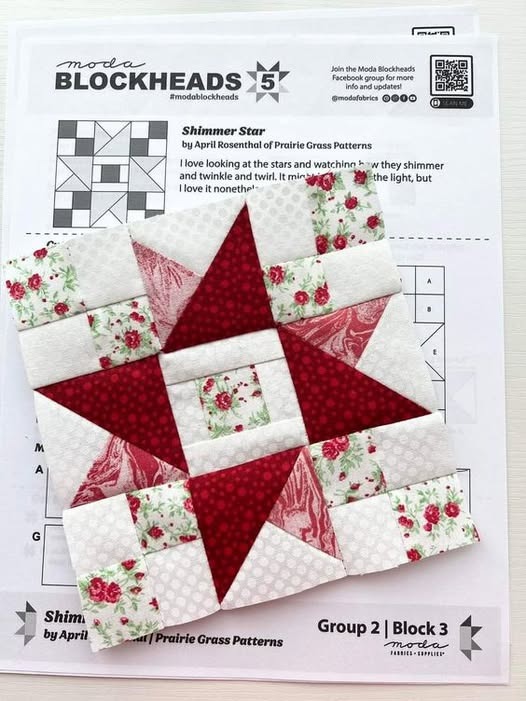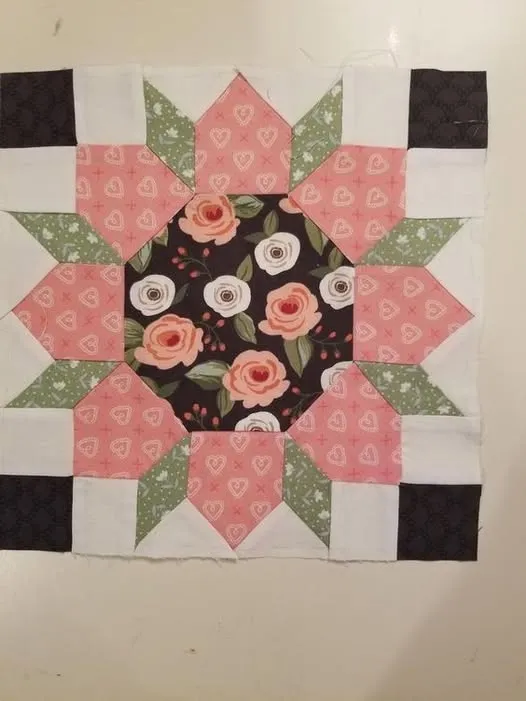
The Sunflower Quilt Block is one of the most charming and cheerful designs in the world of quilting. Inspired by the bright and radiant sunflower, this block brings warmth, happiness, and a touch of summer to any quilt project.
The beauty of this design lies in its versatility — it can be used as a central feature in a large quilt, repeated for a full pattern, or even incorporated into smaller projects like table runners, cushion covers, and wall hangings.
The Sunflower Quilt Block has become a favorite among quilters of all levels because it combines traditional piecing techniques with creative expression, allowing each creator to bring their own personality to the work.

Working on a Sunflower Quilt Block is not only an artistic experience but also a meditative one. The process of choosing fabrics, cutting precise pieces, and sewing them together to form the petals and center creates a rhythmic and satisfying flow.
Whether you prefer bold yellows and oranges for a realistic sunflower or pastel tones for a softer touch, this block can adapt to your unique style. Many quilters enjoy experimenting with fabric textures as well, mixing cottons with batiks or prints to give the petals extra depth and dimension.
What makes the Sunflower Quilt Block even more special is its symbolic meaning. The sunflower is often associated with happiness, vitality, and warmth — qualities that naturally make any handmade quilt feel more inviting. Creating a sunflower quilt for a loved one can symbolize positivity and care, making it a meaningful gift for birthdays, housewarmings, or simply as a heartfelt gesture. As a result, this design remains timeless and continues to inspire both beginners and experienced quilters.
Selecting fabrics for your Sunflower Quilt Block is one of the most enjoyable steps in the creative process. The choice of fabric can completely transform the look and feel of your quilt. For a traditional look, many quilters choose bright yellow fabrics for the petals, brown or black for the center, and shades of green for the background to represent leaves. If you want a more modern or abstract effect, try unconventional colors like coral, teal, or lavender. These can make your design stand out while maintaining the sunflower’s recognizable shape.
Texture is another key element. Mixing different types of fabrics, such as cotton with linen or textured quilting fabrics, can add depth and interest to your design. Batik fabrics, known for their rich color variations, are a favorite for sunflower petals because they mimic the natural shading seen in real flowers. When combining fabrics, be sure that the tones complement each other, avoiding patterns that are too busy, which might distract from the main design.
If you want your Sunflower Quilt Block to have a glowing effect, try using fabrics with subtle gradients or prints that fade from light to dark. This helps create a sense of light and movement within the petals. You can also add a contrasting background to make the sunflower pop — dark blue or deep green fabrics work beautifully to make the yellow petals shine.
Another helpful tip is to pre-wash all your fabrics before cutting. This prevents any color bleeding later and ensures that your quilt remains vibrant and crisp even after washing. Once your fabrics are ready, iron them carefully to remove any wrinkles, which will help you achieve more precise cuts.
Color placement also plays a major role in the success of your block. Experiment by laying out your fabric pieces before sewing. Move them around until you find the combination that feels balanced and eye-catching. Taking a photo can also help you see how the colors interact from a distance.
Finally, remember that the fabric you choose will not only affect the aesthetic but also the mood of your quilt. Softer tones create a peaceful, gentle atmosphere, while bright and bold hues evoke energy and happiness. Your Sunflower Quilt Block should reflect the emotion you want your finished piece to convey.
Creating your Sunflower Quilt Block starts with careful planning and accurate cutting. Begin by choosing your pattern — many free templates are available, but you can also draw your own based on your desired size and style. The block usually consists of a circular center surrounded by multiple pointed or rounded petal shapes, all pieced together with a square or rectangular background.
First, cut your fabric pieces according to your template. Precision is key; even a small mistake in cutting can affect how the pieces fit together. Using a rotary cutter and a self-healing mat helps achieve cleaner edges. Labeling each piece with a small fabric-safe marker or sticker can also make assembly easier.
Next, start by sewing the petals together. Depending on the design, you may need to piece them into sections before attaching them around the center circle. Press your seams carefully as you go to keep everything flat and aligned. When joining the petals to the center, pin each one securely before sewing to avoid uneven gaps.
Once the flower is assembled, attach it to the background fabric. You can either piece it directly or use appliqué techniques if you prefer a more layered look. If you are new to appliqué, fusible webbing can make this step easier by holding the pieces in place while you sew around the edges.
After completing your Sunflower Quilt Block, it’s time to add the finishing touches. Quilting stitches can enhance the look of your design — try outlining the petals with decorative stitches or adding subtle quilting lines radiating from the center to emphasize the sunflower’s shape.
Finally, square up your block to ensure all sides are even. This will make it easier to join with other blocks later. Once you have several blocks finished, you can arrange them into a full quilt, alternating with plain blocks or other floral patterns to create a cohesive and vibrant layout.
The Sunflower Quilt Block can be used in many creative ways beyond traditional quilts. One of the most popular ideas is to use it as the centerpiece of a wall hanging. A large sunflower design framed by smaller blocks or borders creates a stunning decorative piece that brightens any room.
Another fun option is to make a table runner using several sunflower blocks in a row. This brings a cheerful touch to your dining table, especially during summer or fall gatherings. Matching placemats or napkin rings using small sunflower appliqués can complete the set beautifully.
If you love making gifts, a cushion cover featuring a Sunflower Quilt Block is both thoughtful and practical. You can customize it with your recipient’s favorite colors or use fabrics that complement their home decor. Adding a simple border and a backing fabric is all you need to turn a single block into a stylish cushion.
Mini quilts are another creative way to use this block. These small projects are great for beginners or when you want to practice your quilting skills without committing to a large quilt. You can hang mini quilts on doors, windows, or small wall spaces for an instant burst of color.
For those who enjoy fashion sewing, consider incorporating the Sunflower Quilt Block into a tote bag or apron. These unique handmade pieces showcase your quilting skills and make beautiful, eye-catching accessories.
Lastly, don’t forget to experiment with mixed media. Adding embroidery details or fabric paint can elevate your sunflower design even further, allowing you to personalize your project with textures and artistic flair.
To achieve the best results with your Sunflower Quilt Block, start by maintaining accuracy in every step. Measure twice and cut once — this age-old advice truly makes a difference in quilting. Consistency in your seam allowance is also essential; even small variations can distort your block’s shape.
When sewing curves or points, go slowly and use plenty of pins. This ensures smoother, more even results. Pressing each seam as you go helps to keep the block flat and precise. Use a hot iron with steam for best results, but avoid stretching the fabric.
If you find your petals are not aligning perfectly, try trimming small areas instead of forcing them into place. Precision trimming can correct minor mistakes and improve the overall look of your block.
Another tip is to create a test block before starting your main project. This allows you to adjust color combinations, pattern sizes, or seam techniques before committing to a larger quilt.
Keep your workspace organized and well-lit to make the process more enjoyable. Having your fabrics, tools, and pattern easily accessible will save time and reduce frustration.
Lastly, embrace the creative process. Every Sunflower Quilt Block you make will be slightly unique — and that’s the beauty of handmade art. Small imperfections add character and authenticity to your quilt.
1. What size should a Sunflower Quilt Block be?
The size can vary depending on your project. Common sizes range from 8 to 12 inches, but you can easily adjust the template to make larger or smaller blocks.
2. Can beginners make a Sunflower Quilt Block?
Yes! Beginners can start with simple patterns and gradually move to more detailed designs as they gain confidence.
3. What is the best fabric for quilting sunflower designs?
100% cotton is the most popular choice because it’s easy to work with, durable, and available in many colors and prints.
4. How can I make the petals look more realistic?
Use fabrics with slight color gradients or add light shading with fabric markers to give depth and dimension to the petals.
5. Can I use a sewing machine for the appliqué parts?
Absolutely. A sewing machine with a zigzag or blanket stitch setting works perfectly for appliqué techniques.
6. How should I quilt the sunflower design?
You can outline the petals, create echo quilting around the flower, or add free-motion designs to enhance texture.
7. What background color works best?
Dark blues, greens, or even deep grays can make the yellow petals stand out beautifully.
8. Can I combine sunflower blocks with other floral patterns?
Yes, sunflower blocks pair wonderfully with other floral or geometric designs, adding variety and charm to your quilt.
9. How do I care for a sunflower quilt?
Wash it gently in cold water with mild detergent and dry it flat to preserve the colors and stitching.
10. What makes the Sunflower Quilt Block special?
Its timeless beauty, positive symbolism, and endless customization options make it a favorite among quilters worldwide.
The Sunflower Quilt Block is a radiant expression of joy, creativity, and craftsmanship. From selecting the perfect fabrics to assembling the final stitches, every step of creating this block offers a rewarding experience.
Whether used in a full quilt, wall hanging, or cushion cover, this design captures the warmth and optimism of the sunflower itself. If you’ve never tried making one before, now is the perfect time to start your own sunflower-inspired project.
We hope this guide has helped you understand every step and inspired you to create something truly beautiful. Don’t forget to share your thoughts and leave a sincere opinion or suggestions about your experience — your feedback helps keep the quilting community growing and creative.
